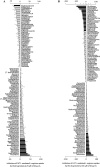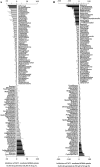Screening of commonly prescribed drugs for effects on the CAT1-mediated transport of L-arginine and arginine derivatives
- PMID: 35377022
- PMCID: PMC9217908
- DOI: 10.1007/s00726-022-03156-2
Screening of commonly prescribed drugs for effects on the CAT1-mediated transport of L-arginine and arginine derivatives
Abstract
The cationic amino acid transporter 1 (CAT1/SLC7A1) plays a key role in the cellular uptake or export of L-arginine and some of its derivatives. This study investigated the effect of 113 chemically diverse and commonly used drugs (at 20 and 200 µM) on the CAT1-mediated cellular uptake of L-arginine, L-homoarginine, and asymmetric dimethylarginine (ADMA). Twenty-three (20%) of the tested substances showed weak inhibitory or stimulatory effects, but only verapamil showed consistent inhibitory effects on CAT1-mediated transport of all tested substrates.
Keywords: ADMA; CAT1; Inhibition; L-Arginine; L-Homoarginine.
© 2022. The Author(s).
Conflict of interest statement
The authors declare that they have no conflict of interest.
Figures



References
-
- Bentur OS, Schwartz D, Chernichovski T, Ingbir M, Weinstein T, Chernin G, Schwartz IF. Estradiol augments while progesterone inhibits arginine transport in human endothelial cells through modulation of cationic amino acid transporter-1. Am J Physiol Regul Integr Comp Physiol. 2015;309(4):R421–427. doi: 10.1152/ajpregu.00532.2014. - DOI - PubMed
-
- Böger RH, Sullivan LM, Schwedhelm E, Wang TJ, Maas R, Benjamin EJ, Schulze F, Xanthakis V, Benndorf RA, Vasan RS. Plasma asymmetric dimethylarginine and incidence of cardiovascular disease and death in the community. Circulation. 2009;119(12):1592–1600. doi: 10.1161/circulationaha.108.838268. - DOI - PMC - PubMed
MeSH terms
Substances
LinkOut - more resources
Full Text Sources
Miscellaneous

